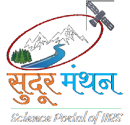Can you name the dustiest planet in our Solar System? It is none other than our closest neighbour, Mars. This dust is responsible for its other names, ‘the Red Planet’ or ‘the Pigpen Planet’. Though the size of Mars is approximately half of that of our planet, but it has similar size of dry land as we have on Earth. Apart from the fact that both Earth and Mars are regularly hit by dust storms, there are several differences.
The Earth’s largest dust storms are usually contributed by deserts like Sahara and the severely affected drought regions, but Martian dust events can originate from almost anywhere. While, Earth’s dust does not usually rise above the tropopause (even if it happens, it is eventually pulled back to the surface); however, Martian dust can rise to higher atmosphere as Mars does not have a tropopause. Weaker gravity, thinner atmosphere and lesser drag and hence, dust can stay longer in the atmosphere.
It has been observed using the ESA’s Mars Express along with NASA’s MRO that the texture of Martian dust storms resembles those of clouds in the Earth’s atmosphere (Sánchez-Lavega et al., 2022). On Earth, the rising air contains water that condenses (leading to cloud formation), while on Mars, this rising air contains dust. Based on size and duration of the Martian dust storms, one can categorize them into broadly four types, i.e., local, regional, planet-encircling/global dust storms and dust devils (Cantor et al., 2001). During a global dust storm, almost the entire planet becomes hazy for several months. In fact, these global dust storms affect several environmental processes on Mars like atmospheric composition, circulation and Aeolian activities.

Figure: Illustration of dusty and clear images of Mars captured by ISRO’s MOM (Data Source: ISSDC/ISRO)
For all the dust it has, one of the key topics of scientific interest is to find out what actually causes these dust events; their frequency and spread. A proper understanding of the Martian dust processes is crucial not only to unravel its past but also to the planning and preparation of future Mars exploration missions.
References:
Cantor, B. A., James, P. B., Caplinger, M., & Wolff, M. J. (2001). Martian dust storms: 1999 Mars Orbiter Camera observations. Journal of Geophysical Research: Planets, 106(E10), 23653–23687. https://doi.org/10.1029/2000JE001310
Lorenz, R., 2022. Attack of The Martian Dust Storms, Air and Space Quarterly, Spring 2022. https://airandspace.si.edu/air-and-space-quarterly/spring-2022/attack-martian-dust-storms
Sánchez-Lavega, A. Erkoreka, J. Hernández-Bernal, T. del Río-Gaztelurrutia, J. García-Morales, I. Ordoñez-Etxeberría, A. Cardesín-Moinelo, D. Titov, S. Wood, D. Tirsch, E. Hauber, K.-D. Matz, 2022. Cellular patterns and dry convection in textured dust storms at the edge of Mars North Polar Cap, Icarus, 387, 115183, https://doi.org/10.1016/j.icarus.2022.115183



